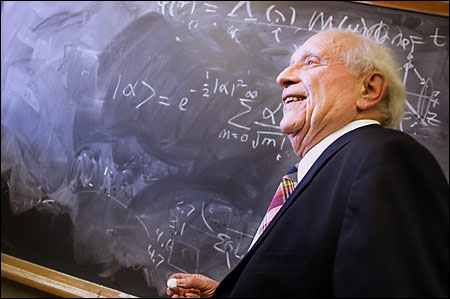Glauber wins Nobel Prize in physics
For pioneering work that shed light on light

Roy J. Glauber, Mallinckrodt Professor of Physics at Harvard University, has won a 2005 Nobel Prize in physics for pioneering work on the nature and behavior of light. Glauber shares the prestigious prize with John L. Hall of the University of Colorado and Theodor W. Hansch of the Institute for Quantum Optics in Munich, Germany. He becomes the 42nd Harvard faculty member to be honored with a Nobel Prize.
The Royal Swedish Academy of Sciences, which selects the winners, reports that the three physicists will share approximately $1.3 million, with Glauber receiving half of that amount. Asked what he would do with more than $640,000, the 80-year-old physicist said, “I haven’t the foggiest.”
Related links:
• Photo gallery
• Downloadable photos
• Announcement
• Faculty Web page
• Harvard’s legacy of Nobel laureates
Glauber was awakened at 5:36 the morning of Tuesday, Oct. 4, by a predawn phone call from Sweden. “I was a little giddy when I heard the news in the black of night,” he said. “I could scarcely believe it; I even thought it might be a joke. I’m just beginning to realize what’s happening. It hasn’t really hit me yet.”
A friendly, unassuming man and a popular teacher, Glauber updated the theory of the nature of light from its origins in the 19th century to include modern quantum principles. He helped explain how light can travel in the form of quanta (particles) as well as rays or waves.
“We are proud to call Roy J. Glauber an alumnus, a distinguished member of the faculty, and now a Nobel laureate,” said Lawrence H. Summers, president of Harvard University. “Professor Glauber is a true luminary whose brilliant research established the basis of quantum optics [the modern theory of light]. For more than 50 years, he has also been a dedicated teacher and mentor who has touched the lives of countless students from graduate-level courses to freshman seminars. On behalf of the entire University community, I want to offer our sincere thanks for his service and our warmest congratulations for the honor bestowed on him.”
Dean of the Faculty of Arts and Sciences William C. Kirby said, “Light and understanding are often used synonymously. Professor Glauber’s work has helped us understand even the nature of light more fully. He has brought great honor to himself, and to this university, and I am proud to congratulate him on winning the Nobel Prize.”
“The prize is long overdue,” adds John Huth, professor and chairman of the Department of Physics. “I think it’s fair to say that Roy discovered a vein of gold that continues to be mined. And he continues to provide leadership in the renaissance that has followed. Roy also participates in the latest research in nuclear physics, studying the behavior of matter when compressed to ultra-high densities.” That is the state that matter was in during and immediately after the origin of the universe.
Glauber says that his interest in physics dates to his teenage years. He spent much of his time building things, including a telescope, and his interest began blossoming when he was 14. “I taught myself lots of math when I was in high school,” he said at a press conference.
As an undergraduate at Harvard, Glauber took graduate-level math courses and worked on the Manhattan Project, which developed the first atomic bomb, before he graduated. He first worked at what he calls “routine” tasks, and then participated in the “calculations that were important in determining the critical mass (of explosives) and the efficiency of the explosion.”
Glauber worked on the atomic bomb from 1944 to 1946, and graduated summa cum laude from Harvard College in 1946. He went on to earn a Harvard Ph.D. in 1949. Afterward, he did research at several world-class institutions, including the Institute for Advanced Studies at Princeton, where Albert Einstein labored over relativity in his later years, and the California Institute of Technology. In 1952, he returned to Harvard, where he has done research and taught ever since.
Glauber came up with the theoretical breakthrough for which he won this year’s Nobel Prize in the early 1960s. And he has yet to slow down.
– Alvin Powell also contributed to this story




